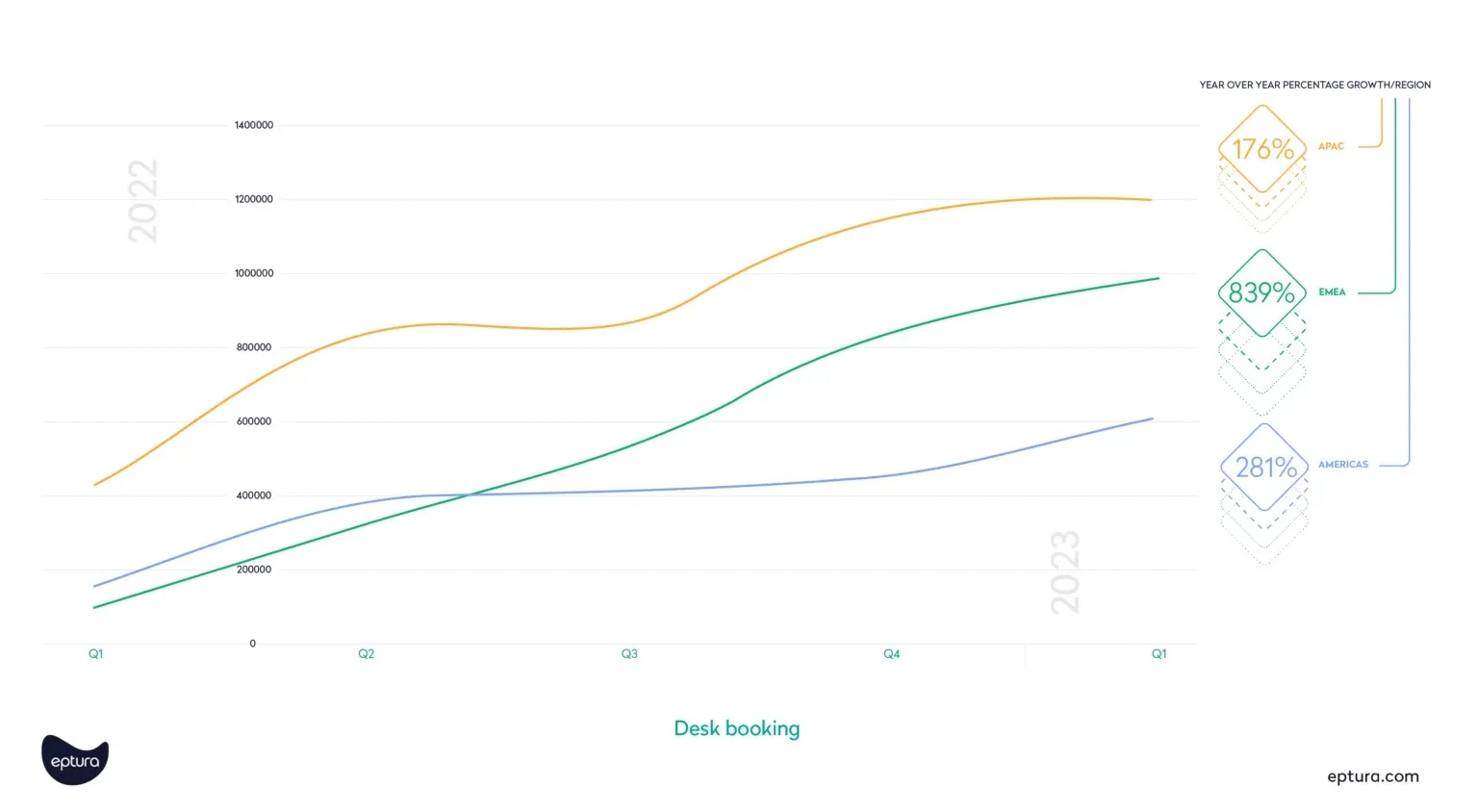
As day-to-day work models have dramatically shifted, what kind of workplace experience are most employees having in 2023? We are examining this very closely.
For the first time, we’re offering insight into macro trends using our proprietary global data. With 16.3M users spanning 16,000+ customers, we’re able to pinpoint how the physical workspace operates end to end via data analysis. We can see information from asset maintenance and site inspections, to visitor management, and office floorplans for space planning across building and real estate portfolios.
Based on our research, we’ve identified a set of benchmark patterns. These patterns are organized around four consistently recurring workplace tensions observed within our customer base. But our insights are also qualitatively based on thousands of customer and industry conversations with facility managers and operations leaders, including those from our two podcasts – Workplace Innovator and Asset Champion.
One of the most pressing tensions for facilities managers to understand from our research is freedom vs. connection. What do we mean? It’s the tension between an individual employee’s desire to work how they want and the need for human connection with other employees.
Get the entire 2023 Workplace Index: Q1 report now.
Why does this matter to a facility manager or workplace strategist? Because it’s a challenge to plan, maintain, and optimize your buildings without accurate utilization metrics. Utilization means behavior. Behavior means people. And workplace behavior today has undergone huge social shifts – which now require more nuanced evaluation and collaboration between many different teams – HR, IT, maintenance teams, others – who are all dependent on reliable and accurate building and facility data.
Plus, 1-to-many space planning models, including the many flavors of hybrid work – have a different set of costs and benefits. And these relatively new, post-pandemic models are having a major effect on building and office moves, vendor management and contracts, ESG standards, regulatory compliance, and inventory management.
When these new models are managed well, they can save time and energy, and boost employee morale and productivity. If they are done poorly, they can shrink a department’s budget and leave an incomplete picture of the workplace.
Employee freedom of choice and the physical workspace
Today’s workplace experience is dynamic – and changing rapidly. The idea of employee freedom is not a brand-new concept, but it has experienced a rapid rate of adoption over the last few years as working from home became a necessity.
Today, business leaders and employees are testing the boundaries of workplace freedom. Leaders need and want engaged and productive employees. Autonomy with accountability deepens employee trust, finds Gallup researchers. Gallup tracks and publishes findings on the top workplaces as measured by employee engagement. The top companies have 18 engaged employees for every one actively disengaged employee.
Depending on what region of the world you work in, the experience of who is in the office and for how many days a week is wholly unique today. Per our research, all regions spanning Asia Pacific (APAC), Europe, the Middle East, and Africa (EMEA) and Americas saw year over year increases in desk bookings from all of 2022 through the first quarter of 2023:

All regions, however, are not responding the same. Global desk booking data show office returns starting in APAC, then moving around the world. Customers in APAC countries are pushing to collaborate and drive innovation with in-office team cultures. European regions are fast followers with in-office attendance rising across multiple industries. And in the Americas, larger cities are leading the charge of in-office occupancy.
In similar vein, our year over year data shows a consistent rise in desk bookings by days of week – especially during the midweek days of Tuesday, Wednesday, and Thursday. Also, there’s been strong year over year expansion in meeting room bookings where we analyzed over 10 million individual meeting rooms in our platform:
- APAC: 50%
- EMEA: 84%
- Americas: 46%
See all of the data charted in the full report.
The human need for social connection
Having a close teammate or friend at work is very important to team success, accountability, loyalty, and ultimately, profitability and employee retention. Gallup research has consistently shown since 2018 and through the pandemic that having a best friend at work increases all of these important productivity metrics.
Once meetings happen in person, our data shows increasingly greater populations of the workforce get back into the rhythm and ritual of going into the office. The effect? It attracts others into the office.
The Americas may appear to be trailing behind other regions with in-office attendance. But when the workforce is in, they are much more likely to be collaborating and booking meeting rooms rather than individual desks alone. This reinforces the mantra in the US that being on-site is the new off-site experience. It means team members are coming together to meet in the office to hold in-depth collaborative sessions.
From a vertical industry perspective, the software and technology industry experienced the biggest growth in collaborative room bookings, up 495% since January 2022 through Q1 2023 – with a large increase of over 100,000 bookings more between from February to March 2023.
The human need for social connection at work is vital to an organization’s culture. And the office provides a way to help us boost productivity – especially when systems in the office work well. Eptura survey research featured in our 2023 Predictions Report reinforces the value of being in an office a few days a week in the US:
- 45% see the improved ability to meet with colleagues, clients, vendors
- 36% believe coming into the office helps improves company culture
- 35% say they look to the office for a productive, well-equipped environment
- 32% feel coming to the office helps with work/life balance
Other data sources reinforce the value and desire for human connection at work. Microsoft’s “2022 Work Trend Index” report found strong interest for social connection:
- 84% of employees would be motivated by the promise of socializing with co-workers
- 85% would be motivated by rebuilding team bonds
- 73% of employees would go to the office more frequently if they knew their direct team members would be there
- 74% would go in if their work friends were there
The bottom line: We want to work and socialize together in person.
How to balance workplace freedom and social connection
How can workplace and facility leaders balance the freedom vs. connection tension? By creating a culture of transparency, trust, and accountability to individual and team performance.
Establish the value of being together in-person
There are many reasons people need and want to work together. A team is a diverse mix of personalities and work styles, so the best way to understand where everyone is at is to ask.
Use employee surveys to establish where your culture is at – and where it wants to be. So first, find out what your teams need when working together in person. And publish the data and responses on a regular cadence. The surveys will reveal what direction your policies should head.
Create flexible hybrid work policies with clarity and buy-in
One of the best ways to establish buy-in is to have department managers work with their teams to create the policies together. The goal is to encourage participation. This way, it’s clear because the team had input. Then, work with other departments on scheduling days.
To help balance out shared workspace and avoid every team being during the midweek mountain, some of our customers are using Mondays and Fridays as alternate days. Often, they are adding in a social component – an end of the week happy hour or early week team brainstorming session – so there’s emphasis on bonding.
Leverage worktech that reinforces freedom and connection to others
After establishing surveys and buy-in to policies, you will have agreement. But we all know that policies are not necessarily going to be strictly followed every week. Each employee will have specific needs, and as long as there is fairness in the approach and employees are performing well in their roles, flexibility and connection will become respected and balanced.
But to take transparency to the next level, it helps to make it easy to know each other’s plans.
With presence awareness – you can leverage simple, easy to view and share scheduling and location data which will help all teams be able to plan and track how workspaces are being used. With this weekly data, you can optimize the short term and inform the future.
Stay tuned. We’re doing a series of blogs on all the tensions our research discovered, including workplace flexibility vs. certainty, value add vs. cost center, and C02 targets vs. costs.
Download the 2023 Workplace Index: Q1 report now.


